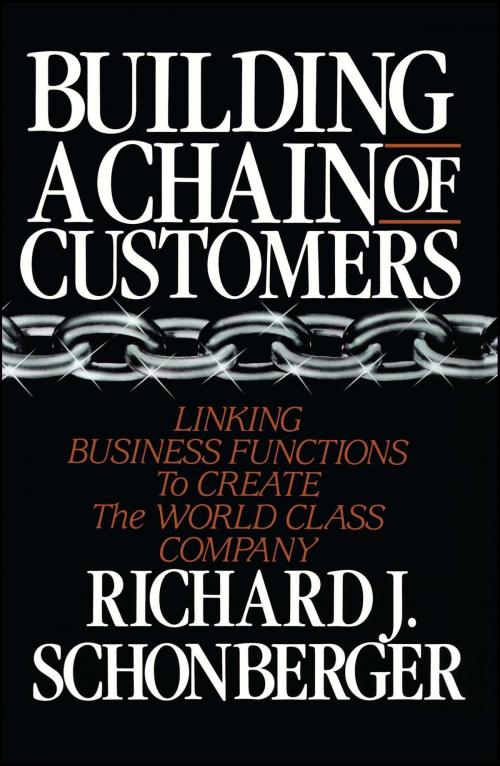Building a Chain of Customers
Business & Finance, Marketing & Sales, International, Personal Finance| Author: | Richard J. Schonberger | ISBN: | 9781439138236 |
| Publisher: | Free Press | Publication: | May 11, 2010 |
| Imprint: | Free Press | Language: | English |
| Author: | Richard J. Schonberger |
| ISBN: | 9781439138236 |
| Publisher: | Free Press |
| Publication: | May 11, 2010 |
| Imprint: | Free Press |
| Language: | English |
Richard Schonberger, in his fourth and most important book yet, introduces a powerful new concept: that the many links between and within the four main business functions -- design, operations, accounting, and marketing -- form a continuous "chain of customers" that extends to those who buy the product or service. Everyone has a customer -- the next department, office, shop, or person -- at the hundreds of pioneering companies Schonberger has studied throughout the world.
Schonberger demonstrates the universality of customer wants: Both the next and final customers want ever better quality, quicker response, greater flexibility, and lower cost. This condition provides a common strategy and calls for common methods to be used across the organization. Every employee is a data gatherer and analyst, unearthing more and better ways to provide for these customers' wants -- before the competition does so.
As the new thinking and methods permeate every comer of the firm, they topple departmental walls and adjust gang-like mind-sets and "them-versus-us" attitudes. Performance is no longer measured by internal costs but by improvement as seen by the next customer; direct control of causes generally replaces after-the-fact control of costs. Design is brought out of isolation. Finally, with the rest of the firm reoriented toward customer service, marketing escapes from a "negative" mode -- covering up for failures -- to a positive one -- crowing about the firm's competence and ability to improve.
With the close attention to detail for which he has become famous, Schonberger constructs a blueprint for unifying corporate functions, brilliantly describing the new microcosms that will make up the company of the 1990s -- focused teams of multi-skilled, involved employees arranged according to the way the work flows or the service is provided -- that compose the chain of customers. Aetna, for example, is organizing customer-focused teams that cut across underwriting and the administrative functions. At Hewlett-Packard, teams of marketing, manufacturing, and R&D people have already gone through several iterations of "activity-based costing", which provides product designers with previously unavailable data for shaving costs throughout product life cycles. And at Du Pont, even production people on the factory floor are involved in assessing competitors' product quality and probable costs and methods. Through these and hundreds of other real company examples, Schonberger shows how the customer-driven chain of action leads directly to the kinds of bottom-line performance that have been so elusive to executives who manage at a distance "by the numbers" -- namely, higher profits, greater security, and gains in market share at the expense of the laggard competion.
Richard Schonberger, in his fourth and most important book yet, introduces a powerful new concept: that the many links between and within the four main business functions -- design, operations, accounting, and marketing -- form a continuous "chain of customers" that extends to those who buy the product or service. Everyone has a customer -- the next department, office, shop, or person -- at the hundreds of pioneering companies Schonberger has studied throughout the world.
Schonberger demonstrates the universality of customer wants: Both the next and final customers want ever better quality, quicker response, greater flexibility, and lower cost. This condition provides a common strategy and calls for common methods to be used across the organization. Every employee is a data gatherer and analyst, unearthing more and better ways to provide for these customers' wants -- before the competition does so.
As the new thinking and methods permeate every comer of the firm, they topple departmental walls and adjust gang-like mind-sets and "them-versus-us" attitudes. Performance is no longer measured by internal costs but by improvement as seen by the next customer; direct control of causes generally replaces after-the-fact control of costs. Design is brought out of isolation. Finally, with the rest of the firm reoriented toward customer service, marketing escapes from a "negative" mode -- covering up for failures -- to a positive one -- crowing about the firm's competence and ability to improve.
With the close attention to detail for which he has become famous, Schonberger constructs a blueprint for unifying corporate functions, brilliantly describing the new microcosms that will make up the company of the 1990s -- focused teams of multi-skilled, involved employees arranged according to the way the work flows or the service is provided -- that compose the chain of customers. Aetna, for example, is organizing customer-focused teams that cut across underwriting and the administrative functions. At Hewlett-Packard, teams of marketing, manufacturing, and R&D people have already gone through several iterations of "activity-based costing", which provides product designers with previously unavailable data for shaving costs throughout product life cycles. And at Du Pont, even production people on the factory floor are involved in assessing competitors' product quality and probable costs and methods. Through these and hundreds of other real company examples, Schonberger shows how the customer-driven chain of action leads directly to the kinds of bottom-line performance that have been so elusive to executives who manage at a distance "by the numbers" -- namely, higher profits, greater security, and gains in market share at the expense of the laggard competion.















